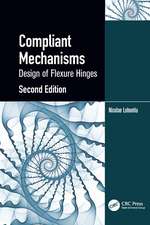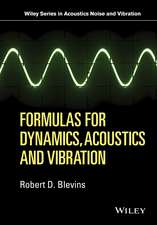Introduction to Aerospace Materials: Woodhead Publishing in Materials
Autor Adrian P Mouritzen Limba Engleză Paperback – 22 mai 2012
- Reviews the main structural and engine materials used in aircraft, helicopters and space craft in terms of their properties, performance and applications
- Introduces the reader to the range of aerospace materials, focusing on recent developments and requirements, and discusses the properties and production of metals for aerospace structures
- Chapters look in depth at individual metals including aluminium, titanium, magnesium, steel and superalloys
Din seria Woodhead Publishing in Materials
- 24%
 Preț: 1130.88 lei
Preț: 1130.88 lei - 29%
 Preț: 802.17 lei
Preț: 802.17 lei - 28%
 Preț: 1019.18 lei
Preț: 1019.18 lei - 23%
 Preț: 1137.01 lei
Preț: 1137.01 lei - 9%
 Preț: 899.92 lei
Preț: 899.92 lei - 9%
 Preț: 1077.86 lei
Preț: 1077.86 lei - 9%
 Preț: 812.81 lei
Preț: 812.81 lei - 29%
 Preț: 1475.86 lei
Preț: 1475.86 lei - 29%
 Preț: 1190.06 lei
Preț: 1190.06 lei - 24%
 Preț: 1737.72 lei
Preț: 1737.72 lei - 31%
 Preț: 1632.08 lei
Preț: 1632.08 lei - 32%
 Preț: 1131.78 lei
Preț: 1131.78 lei - 23%
 Preț: 965.86 lei
Preț: 965.86 lei - 24%
 Preț: 1508.26 lei
Preț: 1508.26 lei - 24%
 Preț: 1479.70 lei
Preț: 1479.70 lei - 27%
 Preț: 1886.90 lei
Preț: 1886.90 lei - 24%
 Preț: 1279.89 lei
Preț: 1279.89 lei - 24%
 Preț: 1336.99 lei
Preț: 1336.99 lei - 24%
 Preț: 1251.34 lei
Preț: 1251.34 lei - 24%
 Preț: 1129.17 lei
Preț: 1129.17 lei - 27%
 Preț: 1444.04 lei
Preț: 1444.04 lei - 24%
 Preț: 1189.10 lei
Preț: 1189.10 lei - 24%
 Preț: 1130.55 lei
Preț: 1130.55 lei - 24%
 Preț: 1249.84 lei
Preț: 1249.84 lei - 20%
 Preț: 1306.34 lei
Preț: 1306.34 lei - 23%
 Preț: 1250.74 lei
Preț: 1250.74 lei - 9%
 Preț: 1246.54 lei
Preț: 1246.54 lei - 9%
 Preț: 1045.22 lei
Preț: 1045.22 lei
Preț: 456.88 lei
Preț vechi: 537.51 lei
-15% Nou
Puncte Express: 685
Preț estimativ în valută:
87.44€ • 90.95$ • 72.18£
87.44€ • 90.95$ • 72.18£
Carte disponibilă
Livrare economică 25 martie-08 aprilie
Livrare express 08-14 martie pentru 52.57 lei
Preluare comenzi: 021 569.72.76
Specificații
ISBN-13: 9781855739468
ISBN-10: 1855739461
Pagini: 640
Dimensiuni: 175 x 245 x 35 mm
Greutate: 1.02 kg
Editura: ELSEVIER SCIENCE
Seria Woodhead Publishing in Materials
ISBN-10: 1855739461
Pagini: 640
Dimensiuni: 175 x 245 x 35 mm
Greutate: 1.02 kg
Editura: ELSEVIER SCIENCE
Seria Woodhead Publishing in Materials
Cuprins
Preface
Chapter 1: Introduction to aerospace materials
1.1 The importance of aerospace materials
1.2 Understanding aerospace materials
1.3 Introducing the main types of aerospace materials
1.4 What makes for a good aerospace material?
1.5 Summary
Chapter 2: Aerospace materials: past, present and future
2.1 Introduction
2.2 Brief history of aerospace materials
2.3 Materials for the global aerospace industry
2.4 Future advances in aerospace materials
2.5 Summary
Chapter 3: Materials and material requirements for aerospace structures and engines
3.1 Introduction
3.2 Fixed-wing aircraft structures
3.3 Helicopter structures
3.4 Space shuttle structures
3.5 Summary
Chapter 4: Strengthening of metal alloys
4.1 Introduction
4.2 Crystal structure of metals
4.3 Defects in crystal structures
4.4 Strengthening of metals
4.5 Summary
4.6 Terminology
Chapter 5: Mechanical and durability testing of aerospace materials
5.1 Introduction
5.2 Tension test
5.3 Compression test
5.4 Flexure test
5.5 Hardness test
5.6 Fracture test
5.7 Drop-weight impact test
5.8 Fatigue test
5.9 Creep test
5.10 Environmental durability testing
5.11 Certification of aerospace materials
5.12 Summary
5.13 Terminology
Chapter 6: Production and casting of aerospace metals
6.1 Introduction
6.2 Production of metal alloys
6.3 Casting of metal alloys
6.4 Casting processes
6.5 Summary
6.6 Terminology
6.8 Case study: casting defects causing engine disc failure in United Airlines flight 232
Chapter 7: Processing and machining of aerospace metals
7.1 Introduction
7.2 Metal-forming processes
7.3 Hot and cold working of metal products
7.4 Powder metallurgy for production of aerospace superalloys
7.5 Machining of metals
7.6 Summary
7.7 Terminology
Chapter 8: Aluminium alloys for aircraft structures
8.1 Introduction
8.2 Aluminium alloy types
8.3 Non-age-hardenable aluminium alloys
8.4 Age-hardenable aluminium alloys
8.5 Speciality aluminium alloys
8.6 Heat treatment of age-hardenable aluminium alloys
8.7 High-temperature strength of aluminium
8.8 Summary
Chapter 9: Titanium alloys for aerospace structures and engines
9.1 Introduction
9.2 Titanium alloys: advantages and disadvantages for aerospace applications
9.3 Types of titanium alloy
9.4 Titanium aluminides
9.5 Shape-memory titanium alloys
9.6 Summary
9.7 Terminology
Chapter 10: Magnesium alloys for aerospace structures
10.1 Introduction
10.2 Metallurgy of magnesium alloys
10.3 Summary
Chapter 11: Steels for aircraft structures
11.1 Introduction
11.2 Basic principles of steel metallurgy
11.3 Maraging steel
11.4 Medium-carbon low-alloy steel
11.5 Stainless steel
11.6 Summary
11.7 Terminology
Chapter 12: Superalloys for gas turbine engines
12.1 Introduction
12.2 A simple guide to jet engine technology
12.3 Nickel-based superalloys
12.4 Iron–nickel superalloys
12.5 Cobalt superalloys
12.6 Thermal barrier coatings for jet engine alloys
12.7 Advanced materials for jet engines
12.8 Summary
Chapter 13: Polymers for aerospace structures
13.1 Introduction
13.2 Aerospace applications of polymers
13.3 Advantages and disadvantages of polymers for aerospace applications
13.4 Polymerisation
13.5 Thermosetting polymers
13.6 Thermoplastics
13.7 Elastomers
13.8 Structural adhesives
13.9 Mechanical properties of polymers
13.10 Polymer additives
13.11 Polymers for radar-absorbing materials (RAMs)
13.12 Summary
13.13 Terminology
13.15 Case study: space shuttle Challenger accident
Chapter 14: Manufacturing of fibre–polymer composite materials
14.1 Introduction
14.2 Fibre reinforcements for composites
14.3 Production of prepregs and fabrics
14.4 Core materials for sandwich composites
14.5 Composites manufacturing using prepreg
14.6 Composites manufacturing by resin infusion
14.7 Machining of composites
14.8 Summary
14.9 Terminology
14.11 Case study: carbon nanotubes in composites
Chapter 15: Fibre–polymer composites for aerospace structures and engines
15.1 Introduction
15.2 Types of composite materials
15.3 Aerospace applications of fibre–polymer composites
15.4 Advantages and disadvantages of using fibre-polymer composites
15.5 Mechanics of continuous-fibre composites
15.6 Sandwich composites
15.7 Environmental durability of composites
15.8 Summary
15.9 Terminology
Chapter 16: Metal matrix, fibre–metal and ceramic matrix composites for aerospace applications
16.1 Metal matrix composites
16.2 Fibre–metal laminates
16.3 Ceramic matrix composites
16.4 Summary
16.5 Terminology
16.7 Case study: ceramic matrix composites in the space shuttle orbiter
Chapter 17: Wood in small aircraft construction
17.1 Introduction
17.2 Advantages and disadvantages of wood
17.3 Hardwoods and softwoods
17.4 Structure and composition of wood
17.5 Engineering properties of wood
17.6 Summary
17.7 Terminology
17.9 Case study: Spruce Goose (Hughes H-4 Hercules)
Chapter 18: Fracture processes of aerospace materials
18.1 Introduction
18.2 Fracture processes of aerospace materials
18.3 Stress concentration effects in materials
18.4 Fracture mechanics
18.5 Application of fracture mechanics to aerospace materials
18.6 Summary
18.7 Terminology
18.9 Case study fracture in the space shuttle Columbia disaster
18.10 Case study: fracture of aircraft composite radome
Chapter 19: Fracture toughness properties of aerospace materials
19.1 Introduction
19.2 Fracture toughness properties
19.3 Ductile/brittle fracture transition for metals
19.4 Improving the fracture toughness of aerospace materials
19.5 Summary
19.6 Terminology
Chapter 20: Fatigue of aerospace materials
20.1 Introduction
20.2 Fatigue stress
20.3 Fatigue life (S–N) curves
20.4 Fatigue-crack growth curves
20.5 Fatigue of metals
20.6 Fatigue of fibre–polymer composites
20.7 Fretting, acoustic and thermal fatigue
20.8 Summary
20.9 Terminology
Chapter 21: Corrosion of aerospace metals
21.1 Introduction
21.2 Corrosion process
21.3 Types of corrosion
21.4 Corrosion protection of metals
21.5 Summary
21.6 Terminology
21.8 Case study: corrosion in the Aloha Airlines flight 243
Chapter 22: Creep of aerospace materials
22.1 Introduction
22.2 Creep behaviour of materials
22.3 Creep of metals
22.4 Creep of polymers and polymer composites
22.5 Creep-resistant materials
22.6 Summary
22.7 Terminology
Chapter 23: Nondestructive inspection and structural health monitoring of aerospace materials
23.1 Introduction
23.2 Nondestructive inspection methods
23.3 Structural health monitoring (SHM)
23.4 Summary
23.5 Terminology
Chapter 24: Disposal and recycling of aerospace materials
24.1 Introduction
24.2 Metal recycling
24.3 Composite recycling
24.4 Summary
Chapter 25: Materials selection for aerospace
25.1 Introduction
25.2 Materials selection in design
25.3 Stages of materials selection
25.4 Materials property charts
25.5 Structural properties in materials selection
25.6 Economic and business considerations in materials selection
25.7 Manufacturing considerations in materials selection
25.8 Durability considerations in materials selection
25.9 Environmental considerations in materials selection
25.10 Specialist properties in materials selection
25.11 Summary
25.12 Terminology
Index
Chapter 1: Introduction to aerospace materials
1.1 The importance of aerospace materials
1.2 Understanding aerospace materials
1.3 Introducing the main types of aerospace materials
1.4 What makes for a good aerospace material?
1.5 Summary
Chapter 2: Aerospace materials: past, present and future
2.1 Introduction
2.2 Brief history of aerospace materials
2.3 Materials for the global aerospace industry
2.4 Future advances in aerospace materials
2.5 Summary
Chapter 3: Materials and material requirements for aerospace structures and engines
3.1 Introduction
3.2 Fixed-wing aircraft structures
3.3 Helicopter structures
3.4 Space shuttle structures
3.5 Summary
Chapter 4: Strengthening of metal alloys
4.1 Introduction
4.2 Crystal structure of metals
4.3 Defects in crystal structures
4.4 Strengthening of metals
4.5 Summary
4.6 Terminology
Chapter 5: Mechanical and durability testing of aerospace materials
5.1 Introduction
5.2 Tension test
5.3 Compression test
5.4 Flexure test
5.5 Hardness test
5.6 Fracture test
5.7 Drop-weight impact test
5.8 Fatigue test
5.9 Creep test
5.10 Environmental durability testing
5.11 Certification of aerospace materials
5.12 Summary
5.13 Terminology
Chapter 6: Production and casting of aerospace metals
6.1 Introduction
6.2 Production of metal alloys
6.3 Casting of metal alloys
6.4 Casting processes
6.5 Summary
6.6 Terminology
6.8 Case study: casting defects causing engine disc failure in United Airlines flight 232
Chapter 7: Processing and machining of aerospace metals
7.1 Introduction
7.2 Metal-forming processes
7.3 Hot and cold working of metal products
7.4 Powder metallurgy for production of aerospace superalloys
7.5 Machining of metals
7.6 Summary
7.7 Terminology
Chapter 8: Aluminium alloys for aircraft structures
8.1 Introduction
8.2 Aluminium alloy types
8.3 Non-age-hardenable aluminium alloys
8.4 Age-hardenable aluminium alloys
8.5 Speciality aluminium alloys
8.6 Heat treatment of age-hardenable aluminium alloys
8.7 High-temperature strength of aluminium
8.8 Summary
Chapter 9: Titanium alloys for aerospace structures and engines
9.1 Introduction
9.2 Titanium alloys: advantages and disadvantages for aerospace applications
9.3 Types of titanium alloy
9.4 Titanium aluminides
9.5 Shape-memory titanium alloys
9.6 Summary
9.7 Terminology
Chapter 10: Magnesium alloys for aerospace structures
10.1 Introduction
10.2 Metallurgy of magnesium alloys
10.3 Summary
Chapter 11: Steels for aircraft structures
11.1 Introduction
11.2 Basic principles of steel metallurgy
11.3 Maraging steel
11.4 Medium-carbon low-alloy steel
11.5 Stainless steel
11.6 Summary
11.7 Terminology
Chapter 12: Superalloys for gas turbine engines
12.1 Introduction
12.2 A simple guide to jet engine technology
12.3 Nickel-based superalloys
12.4 Iron–nickel superalloys
12.5 Cobalt superalloys
12.6 Thermal barrier coatings for jet engine alloys
12.7 Advanced materials for jet engines
12.8 Summary
Chapter 13: Polymers for aerospace structures
13.1 Introduction
13.2 Aerospace applications of polymers
13.3 Advantages and disadvantages of polymers for aerospace applications
13.4 Polymerisation
13.5 Thermosetting polymers
13.6 Thermoplastics
13.7 Elastomers
13.8 Structural adhesives
13.9 Mechanical properties of polymers
13.10 Polymer additives
13.11 Polymers for radar-absorbing materials (RAMs)
13.12 Summary
13.13 Terminology
13.15 Case study: space shuttle Challenger accident
Chapter 14: Manufacturing of fibre–polymer composite materials
14.1 Introduction
14.2 Fibre reinforcements for composites
14.3 Production of prepregs and fabrics
14.4 Core materials for sandwich composites
14.5 Composites manufacturing using prepreg
14.6 Composites manufacturing by resin infusion
14.7 Machining of composites
14.8 Summary
14.9 Terminology
14.11 Case study: carbon nanotubes in composites
Chapter 15: Fibre–polymer composites for aerospace structures and engines
15.1 Introduction
15.2 Types of composite materials
15.3 Aerospace applications of fibre–polymer composites
15.4 Advantages and disadvantages of using fibre-polymer composites
15.5 Mechanics of continuous-fibre composites
15.6 Sandwich composites
15.7 Environmental durability of composites
15.8 Summary
15.9 Terminology
Chapter 16: Metal matrix, fibre–metal and ceramic matrix composites for aerospace applications
16.1 Metal matrix composites
16.2 Fibre–metal laminates
16.3 Ceramic matrix composites
16.4 Summary
16.5 Terminology
16.7 Case study: ceramic matrix composites in the space shuttle orbiter
Chapter 17: Wood in small aircraft construction
17.1 Introduction
17.2 Advantages and disadvantages of wood
17.3 Hardwoods and softwoods
17.4 Structure and composition of wood
17.5 Engineering properties of wood
17.6 Summary
17.7 Terminology
17.9 Case study: Spruce Goose (Hughes H-4 Hercules)
Chapter 18: Fracture processes of aerospace materials
18.1 Introduction
18.2 Fracture processes of aerospace materials
18.3 Stress concentration effects in materials
18.4 Fracture mechanics
18.5 Application of fracture mechanics to aerospace materials
18.6 Summary
18.7 Terminology
18.9 Case study fracture in the space shuttle Columbia disaster
18.10 Case study: fracture of aircraft composite radome
Chapter 19: Fracture toughness properties of aerospace materials
19.1 Introduction
19.2 Fracture toughness properties
19.3 Ductile/brittle fracture transition for metals
19.4 Improving the fracture toughness of aerospace materials
19.5 Summary
19.6 Terminology
Chapter 20: Fatigue of aerospace materials
20.1 Introduction
20.2 Fatigue stress
20.3 Fatigue life (S–N) curves
20.4 Fatigue-crack growth curves
20.5 Fatigue of metals
20.6 Fatigue of fibre–polymer composites
20.7 Fretting, acoustic and thermal fatigue
20.8 Summary
20.9 Terminology
Chapter 21: Corrosion of aerospace metals
21.1 Introduction
21.2 Corrosion process
21.3 Types of corrosion
21.4 Corrosion protection of metals
21.5 Summary
21.6 Terminology
21.8 Case study: corrosion in the Aloha Airlines flight 243
Chapter 22: Creep of aerospace materials
22.1 Introduction
22.2 Creep behaviour of materials
22.3 Creep of metals
22.4 Creep of polymers and polymer composites
22.5 Creep-resistant materials
22.6 Summary
22.7 Terminology
Chapter 23: Nondestructive inspection and structural health monitoring of aerospace materials
23.1 Introduction
23.2 Nondestructive inspection methods
23.3 Structural health monitoring (SHM)
23.4 Summary
23.5 Terminology
Chapter 24: Disposal and recycling of aerospace materials
24.1 Introduction
24.2 Metal recycling
24.3 Composite recycling
24.4 Summary
Chapter 25: Materials selection for aerospace
25.1 Introduction
25.2 Materials selection in design
25.3 Stages of materials selection
25.4 Materials property charts
25.5 Structural properties in materials selection
25.6 Economic and business considerations in materials selection
25.7 Manufacturing considerations in materials selection
25.8 Durability considerations in materials selection
25.9 Environmental considerations in materials selection
25.10 Specialist properties in materials selection
25.11 Summary
25.12 Terminology
Index
Recenzii
"This comprehensive undergraduate text is descriptive, mathematical and factual in equal measure…This is a sound, well-written text that encourages one to read on – a text no undergraduate (worth his/her place) would ever call boring." --The Aeronautical Journal, August 2013
"This comprehensive undergraduate text is descriptive, mathematical and factual in equal measure. This is a sound, well-written text that encourages one to read on – a text no undergraduate (worth his/her place) would ever call boring. The book is good value for money." --The Aeronautical Journal
"This comprehensive undergraduate text is descriptive, mathematical and factual in equal measure. This is a sound, well-written text that encourages one to read on – a text no undergraduate (worth his/her place) would ever call boring. The book is good value for money." --The Aeronautical Journal





















